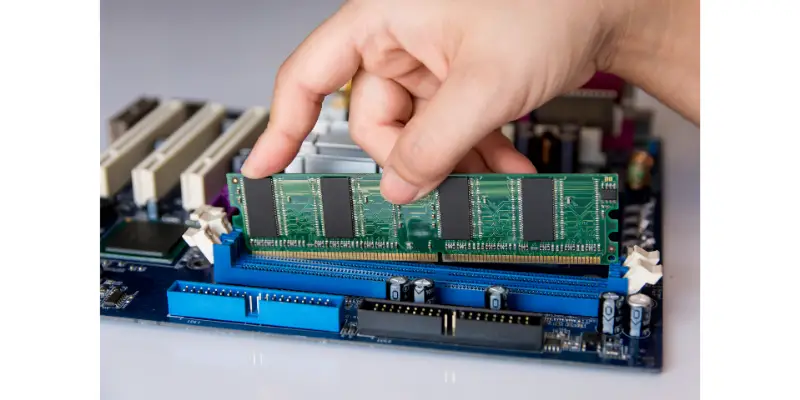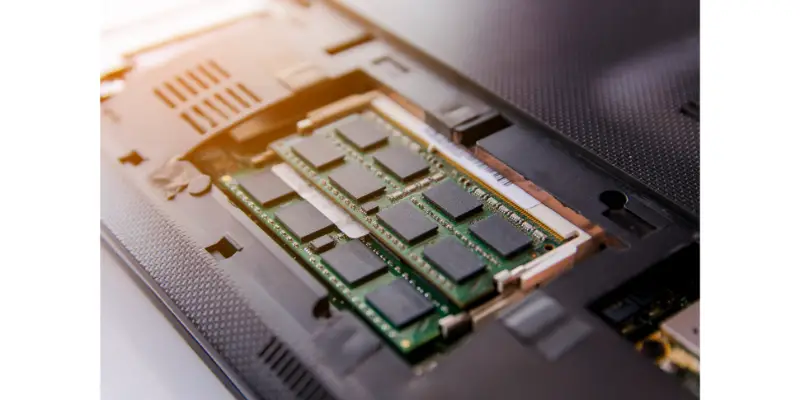Disclaimer: This post may contain affiliate links, meaning we get a small commission if you make a purchase through our links, at no cost to you. For more information, please visit our Disclaimer Page.
Cleaning a ram stick can seem like a daunting task. It’s easy to forget about it and let it build up, but this can lead to trouble.
You can clean a dirty RAM stick by rubbing the contacts or blowing canned air across it. You will then need to dip a cotton swab into isopropyl alcohol, dry it for a while and dust the contact. Rubbing a dry cotton swab onto the RAM stick removes particles and dust.
Table of Contents
How To Clean A Ram Stick
Dirty ram sticks will interfere with the signal. So, it is necessary to clean them regularly to free them from any solid or dust to enhance connections. Dirty RAM sticks make it difficult for the computer to recognize and read the RAM. Therefore, cleaning it may be necessary. It is a simple process that involves the following process:
Option 1- Desktop
If your computer is on, start by shutting it down and unplugging the power cables. Hold the power cable down for a little while to help it discharge any remaining charges. Remove the side panel and the thumbscrews as well. Lay the computer facing upward and attach the strap on your wrist and connect it to the alligator clip on the case. It helps to earth the unit.
Press the holding clip on the side of the RAM and eject it. Use an eraser to clean the contact forth and back. You may also lay the RAM module on a flat surface and use a pencil eraser to clean the contacts.
The first few strokes should result in a dirty erase, meaning that the RAM has picked plenty of dirt. It is this dirt that makes it difficult for your computer to see the RAM. Repeat the process again but if there is any loose dust, blow it off using canned air.
Use a cotton swab to clean the contacts. But ensure to moisten the swab a bit by rubbing some alcohol. Also, use some piece of cloth so that you don’t leave any fiber on the sticks.
Give the RAM some time to dry before you repeat the process on all the sticks. Also, use canned air to blow the RAM bay and dust the case out. Once the RAM stick is dry, please return them to their bay. Also, ensure to line the notches correctly and apply a bit of pressure on either side of the power cable. It ensures that the RAM fits perfectly in its space.
Option 2 – Laptop
You may also clean a RAM stick by following the following steps.
Unplug the computer from the source of power and move it to open space. Touch the case using your finger to reduce the electric charges. It eliminates the chances of electrical shocks when handling the components. Remove the leads to allow you to access the RAM slot. There are cases where you may not easily remove the RAM. So, you will need to be a bit cautious so that you don’t damage the RAM.
Ensure to remove the power cable before you remove the battery. You can do this by sliding the latches on the battery case.
Touch the unpainted metal object to discharge accumulated charges. Make use of the anti-static wrist strap to earth the charges. Alternatively, attach the alligator to any visible metal surface. Hold the power button down for about 5-7 seconds to discharge any remaining charges.
Check out the RAM stick icon to see where the RAM is on the motherboard. Push the latches down using your two fingers until the RAM pops up at an angle of 45 degrees. Slide the RAM from the slot at an angle and hold the module by the edge.
Use a cotton swab and a soft cloth to clean the eraser filling. Note that the cotton swab needs to be rubbed with alcohol and dried fast before using it.
Once you have cleaned the contacts, wipe them until they are smooth. Ensure there are no traces of eraser fillings on the contacts. You can do this by blowing compressed air across the RAM to remove the debris remaining on the contacts.
You may also tap the RAM on a flat surface at the bottom. It helps to loosen and eraser fillings trapped in the heat spreaders. You can then clean Ram sticks and the RAM slots.
The next thing you must do is clean the slots. You can do this using compressed air. Blow the air into the slot and check and confirm that there is no debris left in the slots. Use a good source of light to help you check if they are clean.
Notice that it is important to check and ensure that there is no dust debris left. If you don’t do this, any remaining dust will fall back in the RAM slots. Continue blowing it out until there is no debris left. Once you verify that it is clean, replace the RAM stick.
Ensure to insert the RAM back into its slot at an angle of 45 degrees. Push it down a little bit until it is in the right place. Also, ensure to fill the bottom slot fast and install the RAM. Reinstall the battery and connect it to the source of power.
The last thing you will need to do is to clean the RAM module contacts. Do not return the RAM in its slot before cleaning the RAM module contacts. Do not use any solvent to clean the module contacts because the surface of your RAM is delicate and can quickly get damaged.
Therefore, the best way to clean the contacts is to blow off the dust and pull out the RAM module. It will allow you to clean the RAM faster. Once the slots and RAM modules are free of debris and dust, you can open the clips and reinstall the modules. Ensure they are well oriented by checking out the divider locations in their respective slots. They should match with the RAM module.
Note that you need to remain cautious while rubbing the eraser on the RAM stick. The problem is that it may remove the oxidation and introduce another problem that may make it difficult for your computer to see the RAM. Therefore, ensure to use canned air to blow the dust off the RAM stick. If you choose to use isopropyl, you will need to exercise caution as well. Ensure that it is dry before using it. The best way to do this is to dip it into isopropyl alcohol and set it aside so that it dries.
Finally, you may choose to use fine-grit sandpaper to clean the RAM sticks. But the problem is that it will make the contacts thinner, meaning that they will become loose and uneven. If it happens, they may not fit in the slot and will make it difficult for the computer to see them. Also, the eraser is likely to leave rubber behind and reduce contact.
Consider using 90% alcohol and microfiber cloth to remove debris, dust, and particles on your RAM stick.
Conclusion
Although some people find no reason to clean the RAM when it is not working, it is good to ensure that it is always clean.
The rule of thumb is that consider cleaning it once in a while. It helps to remove any contamination on the contacts.
Also, when dust accumulation is too high, it hinders free airflow, which results in overheating. It may make your computer malfunction.
But remember that RAM sticks are delicate and so you will need to be careful when cleaning them. If you have no technical expertise in opening the computer, consider seeking help from an expert.


